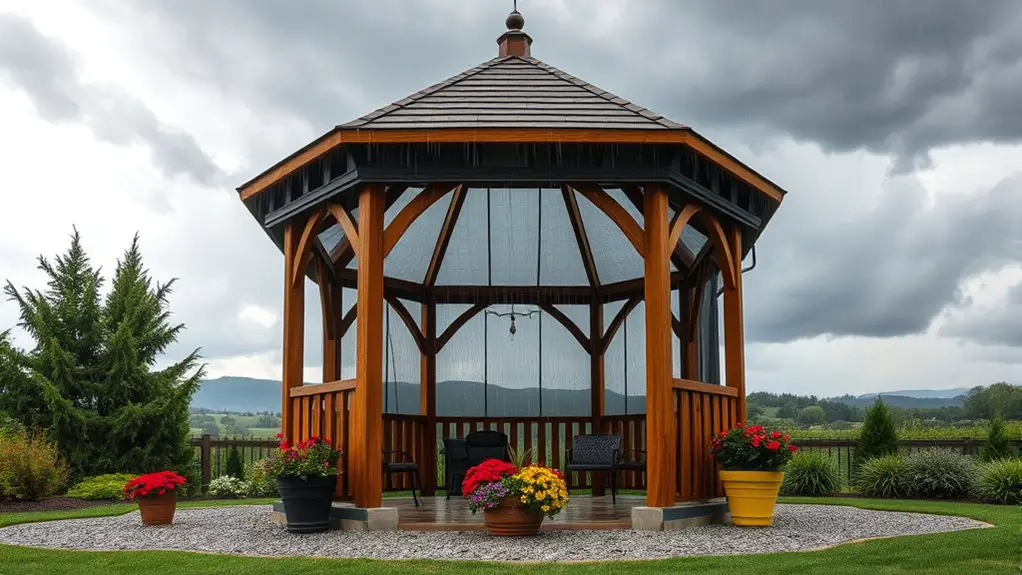To protect your gazebo from harsh weather, start by using durable materials like rot-resistant cedar or aluminum. Implement proper drainage systems, like gutters and gravel trenches, to manage water flow. During the off-season, cover your gazebo with breathable tarps to shield it from moisture. Regular inspections are key, so keep an eye out for rot and guarantee tight screws. For added stability, consider wind damage protection strategies. There’s more to explore for thorough protection techniques.
Choose Durable Materials for Your Gazebo
When you’re selecting materials for your gazebo, it is essential to prioritize durability, especially if you want it to withstand the elements. Start with wood selection; opt for rot-resistant species like cedar or redwood, as they offer both beauty and longevity. These woods naturally fend off moisture and pests, ensuring your investment lasts. Additionally, consider incorporating metal types such as aluminum or steel, which provide a modern aesthetic and are resistant to rot and insects, further enhancing the durability of your gazebo.
Next, consider material coatings. Applying weather-resistant finishes not only enhances the wood’s aesthetic but also provides an extra layer of protection against UV rays and rain. Look for high-quality sealants or stains designed specifically for outdoor use. These coatings can greatly extend the life of your gazebo, preventing warping and discoloration.
Install Proper Drainage Systems
Even with the best materials, a gazebo can suffer from water damage if proper drainage systems aren’t in place. To safeguard your outdoor sanctuary, consider effective drainage solutions that channel water away from the foundation. Start by evaluating the terrain; a slight slope can greatly enhance water management. Install gutters along the roofline to collect rainwater and direct it through downspouts, ensuring it flows away from your gazebo.
Additionally, create a drainage trench lined with gravel around the perimeter. This helps absorb excess water and prevents pooling. If your gazebo is situated in a particularly wet area, a French drain could be a wise investment; it efficiently redirects water from soggy spots. Ensuring proper drainage is essential for maintaining the durability of your gazebo and preventing long-term water damage.
Use Protective Covers During Off-Season
Although your gazebo is built to withstand the elements, using protective covers during the off-season can greatly extend its lifespan and maintain its aesthetic appeal. Investing in high-quality protective materials like waterproof tarps or breathable fabric covers guarantees your gazebo remains shielded from harsh weather conditions. These covers act as a barrier against moisture, UV rays, and debris, preventing deterioration and fading. Additionally, selecting covers made from high-quality materials ensures durability and longevity against environmental factors.
When the seasons change, proper seasonal storage becomes essential. Before covering your gazebo, clean it thoroughly to remove any dirt or grime that could trap moisture underneath. Confirm that the covers fit snugly, allowing for airflow to prevent mold and mildew buildup.
Regularly Inspect and Maintain Your Gazebo
As you enjoy your gazebo throughout the seasons, regularly inspecting and maintaining it is essential for guaranteeing its longevity and functionality. A solid maintenance schedule can prevent costly repairs and keep your outdoor haven looking pristine. Here are four key points for effective gazebo inspections:
- Check for Rot or Damage: Inspect wooden components for signs of rot or insect damage that could compromise structural integrity.
- Examine Roof and Gutters: Verify the roof is intact and gutters are free of debris to prevent water accumulation.
- Tighten Fasteners: Regularly check screws, bolts, and nails; tighten or replace any loose or rusted hardware.
- Clean Surfaces: Remove dirt, mold, and mildew from surfaces to maintain aesthetics and prevent deterioration. Additionally, make sure to apply a protective coating based on gazebo material to safeguard it against weather elements.
Secure Your Gazebo Against Wind Damage
When strong winds whip through your area, guaranteeing your gazebo is securely anchored can prevent it from becoming a costly loss. Start by adding structural reinforcements, like corner brackets and diagonal braces, to enhance stability. Wind barriers, such as shrubs or fencing, can deflect gusts and shield your gazebo from direct impact. Regularly checking the stability of your gazebo’s anchoring techniques will help ensure its safety during severe weather conditions.
Here’s a quick reference table to help you choose effective wind protection strategies:
| Method | Description | Benefits |
|---|---|---|
| Anchor Kits | Use stakes or concrete weights | Prevents uplift and tipping |
| Wind Barriers | Install hedges or screens | Reduces wind speed |
| Structural Reinforcements | Add braces and supports | Increases overall strength |
| Adjustable Legs | Use adjustable feet for leveling | Guarantees stability on uneven ground |
| Regular Inspections | Check stability and wear | Proactively address issues |
Apply Weather-Resistant Finishes
After securing your gazebo against wind damage, protecting it from the elements is the next step. Applying weather-resistant finishes is vital for longevity and aesthetic appeal. Here’s how to get started:
- Choose Weather Resistant Paints: Opt for high-quality, UV-resistant paints that withstand fading and chipping.
- Apply Protective Sealants: Use sealants to create a barrier against moisture, preventing rot and decay.
- Consider Stains for Wood: If your gazebo is wooden, stains can enhance grain visibility while adding protection against water and UV damage.
- Regular Maintenance Checks: Reapply finishes as needed, typically every few years, to guarantee ongoing protection. Additionally, regular checks for leaks and wear can help maintain gazebo integrity, ensuring that it remains a functional outdoor space throughout the year.
Landscape Strategically to Shield From Elements
To effectively shield your gazebo from harsh weather conditions, strategic landscaping plays an essential role in creating a natural barrier. Start with thoughtful plant selection; choose dense, evergreen shrubs and trees that can withstand strong winds. These act as effective windbreak options, reducing gusts that could otherwise damage your structure. Consider planting a mix of heights to create layers of protection, with taller trees at the back and shorter shrubs in front.
Incorporating flowering plants can also enhance aesthetics while serving practical purposes, like absorbing moisture and providing shade. To maximize effectiveness, position your plants at a distance that allows for growth but still creates a formidable barrier. Additionally, mulch around your plants helps retain moisture, promoting healthy growth. By landscaping strategically, you not only protect your gazebo but also enhance your outdoor space, allowing you to enjoy nature’s freedom while safeguarding your retreat. Furthermore, proper care can ensure that your gazebo remains a valuable asset in your outdoor environment for years to come.
Frequently Asked Questions
What Materials Are Best for a Gazebo in Snowy Climates?
Imagine your gazebo as a sturdy ship braving winter seas. For snowy climates, use snow-resistant materials like vinyl and metal, while adding gazebo insulation to keep it cozy and resilient against nature’s icy grip.
How Often Should I Clean My Gazebo to Prevent Damage?
For effective gazebo maintenance, you should clean it at least twice a year. Increased cleaning frequency during harsh weather can prevent buildup, ensuring longevity and preserving your outdoor sanctuary’s beauty and functionality for years to come.
Can I Install a Gazebo on a Slope?
Sure, installing a gazebo on a slope might seem like a thrilling adventure, but slope considerations are essential. Guarantee proper leveling and secure installation; otherwise, you might just have a wobbly, whimsical structure.
Are There Any Plants That May Harm My Gazebo?
Certain plant types, like invasive vines or large trees, can harm your gazebo with aggressive root systems. They may destabilize structures or cause damage, so consider placement carefully to maintain your outdoor sanctuary’s integrity and freedom.
How Do I Know if My Gazebo Needs Repairs?
When you inspect your gazebo, look for signs of damage like warped wood or rusted metal. Regular checks can reveal hidden issues, ensuring your outdoor haven remains a sanctuary, not a crumbling relic of the past.

